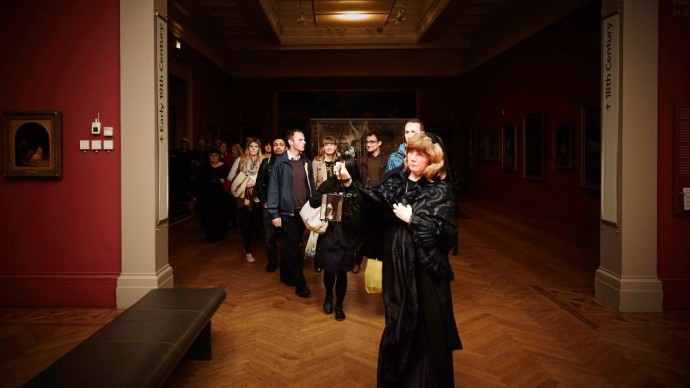Professor Dale Townshend

Professor Dale Townshend FSA
Professor of Gothic Literature
My profile
Biography
Academic and Professional Qualifications
Bachelor of Arts. 1992. University of Witwatersrand, Johannesburg.
Bachelor of Arts with Honours in English. 1993. University of Witwatersrand, Johannesburg.
Master of Arts by Research (English). 1997. University of Witwatersrand, Johannesburg.
PhD (English). 2004. Keele University, Staffordshire.
I am elected Fellow of the Society of Antiquaries.
Selected Research Awards and Fellowships (Since 2015)
- June 2015—December 2016: AHRC Leadership Fellowship (PI) for the project ‘Writing Britain’s Ruins: The Architectural Imagination, 1700-1850’. Grant Ref: AH/M00600X/1. Amount Awarded (80 % of FEC): £181 863. This research grant included the following costings:
- Lewis Walpole Library Fellowship, Yale University: 1 November–1 December 2016, including all travel, accommodation and subsistence grant.
- Yale Centre for British Art and Lewis Walpole Library Travel Grant for Horace Walpole’s The Mysterious Mother: A Mini-Conference, Yale University, May 2018.
- March 2020: British Academy / Leverhulme Trust Small Research Award for archival work towards the completion of my current monograph project, Matthew Gregory Lewis (contracted to University of Wales Press). Amount awarded: £7370.00. This will finance research trips to the USA (Los Angeles and Boston) and Kingston, Jamaica, over a 3-year period (until March 2023)
- March 2020: Awarded an Andrew W. Mellon Foundation Fellowship in Eighteenth-Century Studies at the Huntington Library, California (Academic year 2020–21; postponed to 21–22 academic year): $3500.00 plus travel and visa fees. I took up this month-long Fellowship in term Autumn term of 21–22 academic year.
- December 2021: I was awarded an AHRC Follow-On Funding Grant for a project entitled ‘Experiencing Britain’s Ruins: ‘Revenants and Remains’ at Five Northern English Religious Houses and Beyond’. Grant Ref: AH/W004399/1. Amount Awarded (80 % of FEC): £80, 531. As PI on this project, I will collaborate with colleagues Dr Michael Carter and Dr Dominique Bouchard at English Heritage to develop an intensive year-long programme (January–December 2022)of youth engagement initiatives, guided tours, creative writing workshops and related digital events at five ecclesiastical ruins in the north of England (Byland Abbey, North Yorkshire; Furness Abbey, Cumbria; Lanercost Priory, Cumbria; Rievaulx Abbey, North Yorkshire; and Roche Abbey, South Yorkshire). At a concluding workshop for Heritage professionals in December 2022, I will use the feedback gained from this project to articulate a policy on the use of the Gothic and / or supernatural in for use by the contemporary heritage management sector.
Interests and expertise
My research interests lie in all aspects of Gothic writing (romance; drama; chapbooks; poetry) of the late eighteenth and early nineteenth centuries. Within this broad field, I have worked on a range of topics, including the Gothic in eighteenth-century children’s literature; Gothic appropriations of Shakespeare; Ann Radcliffe; Horace Walpole; William Beckford; Gothic topography; and the relationship between Gothic and Romantic aesthetics. I have recently completed two books on the relationship between architecture and literature in the period 1700–1850, the first a collaborative and interdisciplinary collection of essays entitled Writing Britain’s Ruins (co-edited with Michael Carter and Peter Lindfield; British Library, 2017)and the second, a scholarly monograph entitled Gothic Antiquity: History, Romance and the Architectural Imagination, 1760–1840 (Oxford University Press, 2019). These are two of the many academic outputs of my AHRC Leadership Fellowship, Writing Britain’s Ruins, 1700–1850: The Architectural Imagination (2015–2017). I also have strong research interests in critical theory, particularly in the work of Roland Barthes, Jacques Derrida, Jacques Lacan, Michel Foucault and Emmanuel Levinas; within this more theoretical mode, I am currently working on the ethics of Gothic fiction, from the eighteenth century to the present. With Angela Wright (University of Sheffield), I have recently edited volumes 1 and 2 of The Cambridge History of the Gothic, a major, three-volume collection of essays that is to be published by Cambridge University Press in October 2020. I currently have in press articles and chapters on such topics as ethics, hospitality and the Gothic; Horace Walpole’s Gothic tragedy The Mysterious Mother; and Horace Walpole and Strawberry Hill.
Impact
I am currently PI on an AHRC Follow-On Project entitled “Experiencing Britain’s Ruins: ‘Revenants and Remains’ at Five Northern English Religious Houses and Beyond.”
This project aims to enhance the public ‘experience’ of Britain’s ruins by applying research findings derived from my earlier AHRC Leadership Fellowship, ‘Writing Britain’s Ruins, 1700-1850: The Architectural Imagination’ (AH/M00600X/1; 2015-16), to contemporary practices of heritage interpretation, ruin tourism and creative literary response.
Over a 12-month period, PI Townshend and Co-Is Dr Michael Carter and Dr Dominique Bouchard, both of English Heritage (EH), will deliver, administer and ultimately evaluate ‘Revenants and Remains’, an innovative and exciting programme of free, public-facing digital and real-life activities focused upon, but also radiating outwards beyond, 5 key EH sites of monastic ruin in the north of England: Byland Abbey, North Yorkshire; Furness Abbey, Cumbria; Lanercost Priory, Cumbria; Rievaulx Abbey, North Yorkshire; and Roche Abbey, South Yorkshire.
Responding directly to identified needs within the heritage sector at these sites, this multi-faceted programme for knowledge exchange (KE) and impact generation aims to rearticulate, recreate and embed aspects of the original literary-historical research (1700-1850) in present-day virtual and real-life contexts, showing the relevance of its findings to contemporary acts of ruin tourism so as directly to enrich the general public’s knowledge, appreciation and experience of national history and architectural heritage.
The project website may be found here.

Haunt Manchester
Go to ResearchProjects
Currently, my two major academic projects are a monograph on Matthew Gregory Lewis, which is contracted to the University of Wales Press and due to be delivered in September 2022, and the co-editing, with Elizabeth Bobbit, of Ann Radcliffe’s posthumous works for The Cambridge Edition of the Complete Works of Ann Radcliffe (under the general editorship of Angela Wright and Michael Gamer). I am also at the early stages of a monograph on necromancy in Romantic-period culture.
With Prof. Angela Wright from the University of Sheffield, I co-edit the ‘Elements in the Gothic’ series for Cambridge University Press. For further information on the series, see the website here. Please get in touch if you have any ideas for a short, research-led monograph on any aspect of Gothic Studies.
Teaching
Postgraduate teaching
At Masters level, I convene and teach on ‘The Rise of the Gothic’, an intensive course on Gothic writing from Shakespeare through to the late nineteenth century.
Subject areas
Gothic Writing in all Genres of the Eighteenth and Nineteenth Centuries; Romanticism; Critical Theory.
Supervision
I have supervised numerous PhD students on a wide variety of Gothic and Gothic-related topics, including the pre-history, life and afterlife of Gaston Le Roux’s The Phantom of the Opera; appropriations of Shakespeare in eighteenth-century Gothic writing (AHRC-funded); Ghostly Modernisms; Metatextuality in Modern and Contemporary Gothic; Gothic, Trauma and Representations of Chernobyl; South African Gothic; the Rise of the Sentient Zombie; Post-9/11 American fiction, Trauma and the Gothic; English and French Gothic of the late eighteenth century; theology and eighteenth-century Gothic writing; and Gothic Tourism in and around London.
At present, I am supervising Doctoral projects on Gothic and the Digital Humanities; a cultural history of the animated skeleton, 1740—1900; and Anne Grant and Scottish Romantic culture.
Research outputs
-
Books (authored/edited/special issues)
Townshend, D. (2024) Matthew Gregory Lewis The Gothic and Romantic Literary Culture. University of Wales Press.
Spooner, C., Townshend, D. (2021) THE CAMBRIDGE HISTORY OF THE GOTHIC: VOLUME 3: Gothic in the Twentieth and Twenty-First Centuries.
Wright, A., Townshend, D. (2020) The cambridge history of the gothic: Volume 1, gothic in the long eighteenth century.
Townshend, D., Wright, A. (2020) The Cambridge History of the Gothic.
Townshend, D. (2019) Gothic Antiquity History, Romance, and the Architectural Imagination, 1760-1840. Oxford University Press.
Carter, M., Townshend, D., Lindfield, P.N. (2017) Writing Britain's Ruins.
Wright, A., Townshend, D. (2015) Romantic Gothic: An Edinburgh Companion.
Townshend, D., Staff, B.L. (2014) Terror and Wonder The Gothic Imagination.
Townshend, D. (2013) Introduction.
Byron, G., Townshend, D. (2013) The gothic world.
(2013) Macbeth: A Critical Reader. A&C Black.
Townshend, D. (2012) Gothic Shakespeare.
Townshend, D., Wright, A. (2012) Ann Radcliffe, romanticism and the Gothic.
Drakakis, J., Townshend, D. (2008) Gothic Shakespeares.
Townshend, D. (2007) The Orders of Gothic Foucault, Lacan, and the Subject of Gothic Writing, 1764-1820. Ams PressInc.
Botting, F., Townshend, D. (2004) Gothic critical concepts in literary and cultural studies.
-
Chapters in books
Townshend, D. (2024) ''Gothic Fiction, Romanticism and the Origins of the Nineteenth-Century Ghost Story'.' The Victorian Ghost Story: An Edinburgh Companion. Edinburgh University Press,
Townshend, D., Townshend, D. (2024) ''A Delicious Entertainment for the Closet': Collaborations in the Gothic style in Horace Walpole's The Mysterious Mother (1768).' Horace Walpole's Styles. Liverpool University Press,
Townshend, D. (2023) 'The mystery of The Mysterious Mother: Textual lives and afterlives.' Staging "The Mysterious Mother". pp. 9-22.
Lindfield, P.N., Townshend, D. (2022) 'Metaphor and revivalist architecture at strawberry hill.' The Palgrave Handbook of Gothic Origins. pp. 363-396.
Townshend, D. (2020) 'Guests, Hosts, Ghosts: Towards an Ethics of Gothic Writing.' In Williams, M.A. (ed.) Hospitalities: Transitions and Transgressions, North and South. Routledge,
Townshend, D. (2020) 'The literary gothic before horace walpole's the castle of otranto.' The Cambridge History of the Gothic: Volume 1, Gothic in the Long Eighteenth Century. pp. 67-95.
Townshend, D., Wright, A., Spooner, C. (2020) 'Introduction: The gothic in/and history.' The Cambridge History of the Gothic: Volume 1, Gothic in the Long Eighteenth Century. pp. 1-21.
Townshend, D. (2020) 'Introduction: Gothic in the nineteenth century, 1800-1900.' The Cambridge History of the Gothic. pp. 1-18.
Townshend, D. (2020) 'Convenience, Utility and Comfort in British Domestic Architecture of the Long Eighteenth Century.' The Comforts of Home in Western Europe: 1700-1900. pp. 19-38.
Townshend, D. (2020) ''The Literary Gothic Before _The Castle of Otranto_.' The Cambridge History of the Gothic, Volume I.. Cambridge University Press,
Townshend, D. (2019) 'Gothic and the Question of Ethics: Otherness, Alterity, Violence.' The Gothic and Theory: An Edinburgh Companion. Edinburgh University Press,
Lindfield, P.N., Townshend, D. (2018) 'Reading Vathek and Fonthill Abbey: William Beckford’s architectural imagination.' In Dakers, C. (ed.) Fonthill Recovered: A Cultural History. UCL Press, pp. 284-301.
Townshend, D. (2017) ''Love in a convent': Or, Gothic and the perverse father of queer enjoyment.' Queering the Gothic. pp. 11-35.
Townshend, D. (2016) 'Shakespeare, Ossian and the problem of ‘Scottish Gothic’.' Gothic Renaissance A Reassessment. Oxford University Press,
Townshend, D., Wright, A. (2015) 'Gothic and romantic: An historical overview.' Romantic Gothic: An Edinburgh Companion. pp. 9-44.
Townshend, D. (2014) 'Architecture and the Romance of Gothic Remains: John Carter and The Gentleman’s Magazine, 1797–1817.' Palgrave Gothic. pp. 173-194.
Townshend, D. (2013) 'The haunted nursery: 1764–1830.' The Gothic in Children's Literature: Haunting the Borders. pp. 15-38.
Townshend, D., Wright, A. (2012) 'Gothic and romantic engagements: The critical reception of Ann Radcliffe, 1789–1850.' Ann Radcliffe, Romanticism and the Gothic. pp. 3-32.
Townshend, D. (2008) 'Gothic and the ghost of Hamlet.' Gothic Shakespeares. pp. 60-97.
-
Journal articles
Townshend, D. (2014) 'Ruins, romance and the rise of gothic tourism: The case of Netley Abbey, 1750-1830.' Journal for Eighteenth-Century Studies, 37(3) pp. 377-394.
Townshend, D. (2013) 'T. I. Horsley curties, romance, and the gift of death.' European Romantic Review, 24(1) pp. 23-42.
Townshend, D. (2012) 'Royalist Historiography in T. J. Horsley Curties’s Ethelwina, Or The House of Fitz-Auburne (1799).' Gothic Studies, 14(1) pp. 57-73.
Townshend, D. (2011) 'Improvement and Repair: Architecture, Romance and the Politics of Gothic, 1790–1817.' Literature Compass, 8(10) pp. 712-738.
Ballinger, G., Lustig, T., Townshend, D. (2005) 'Missing intertexts: Hannah craft's the Bondwoman's Narrative and African American literary history.' Journal of American Studies, 39(2) pp. 207-237.
Townshend, D. (2004) 'Gothic panoptics and the persistence of torturous enjoyment, 1764-1820.' Genre, 37(3-4) pp. 395-432.
Townshend, D. (1998) 'Work and text in the later writings of roland barthes.' Journal of Literary Studies, 14(3-4) pp. 392-430.
Townshend, D. (1997) 'Transgression, writing and violence in romantic gothic fiction, 1794–1820.' Journal of Literary Studies, 13(1-2) pp. 151-189.
